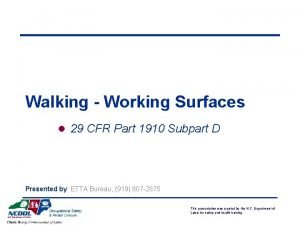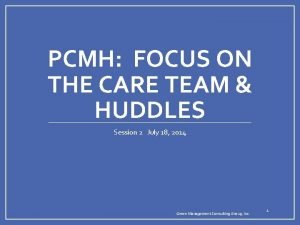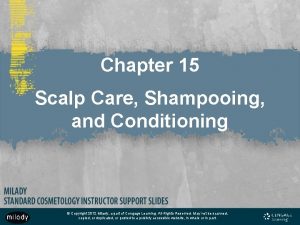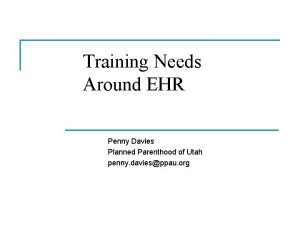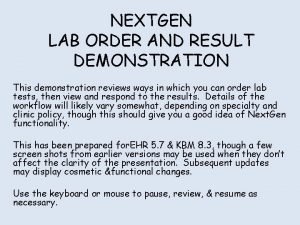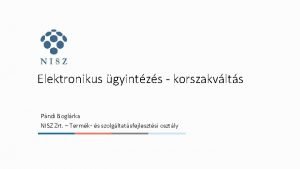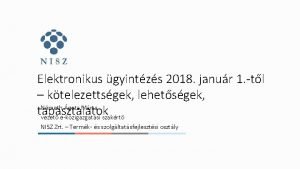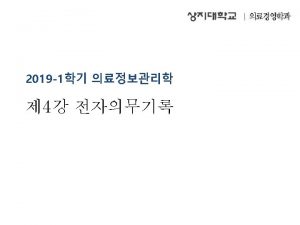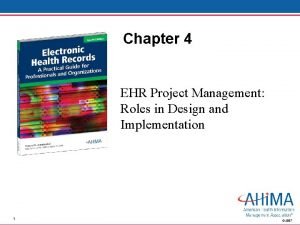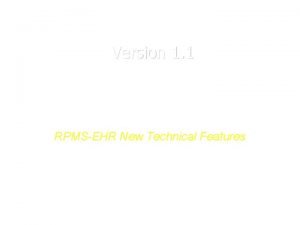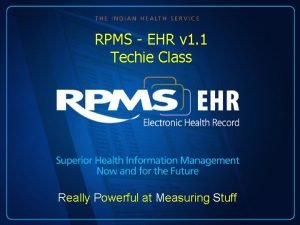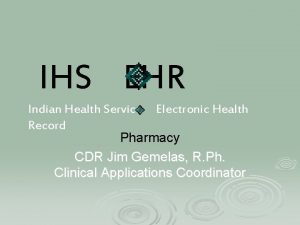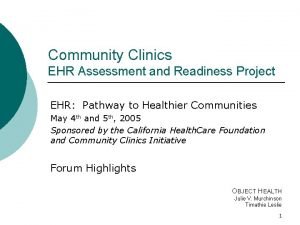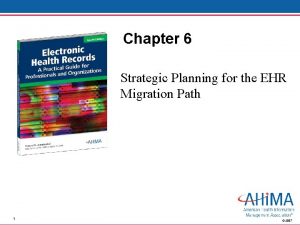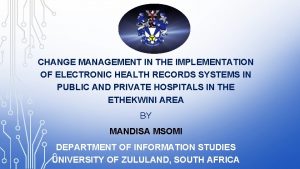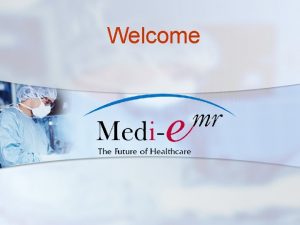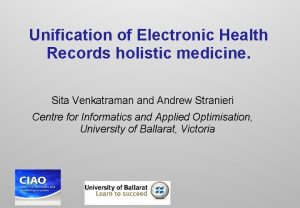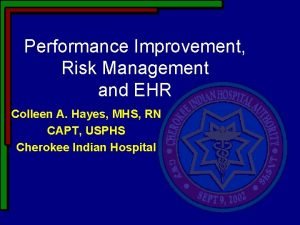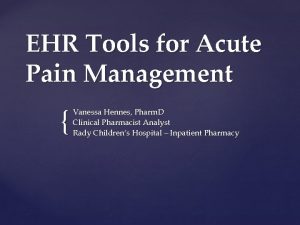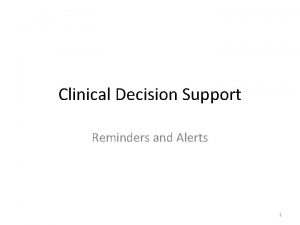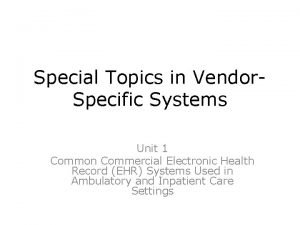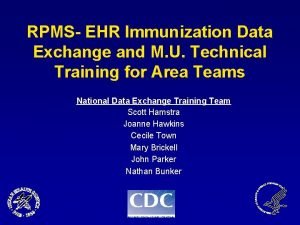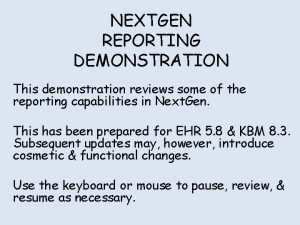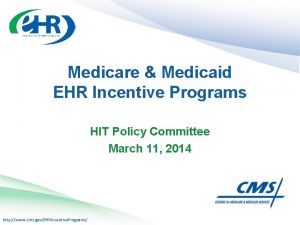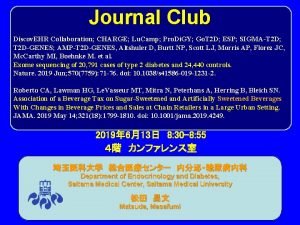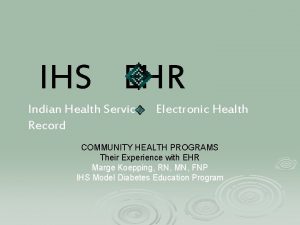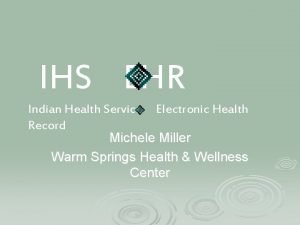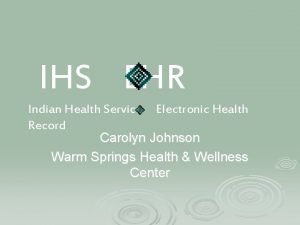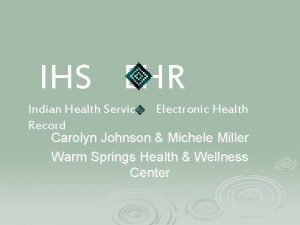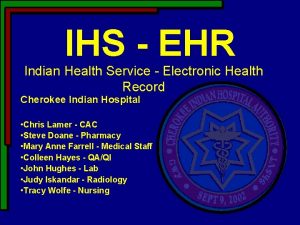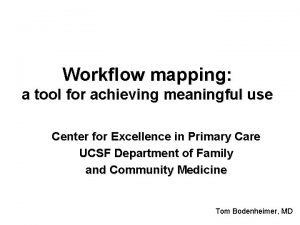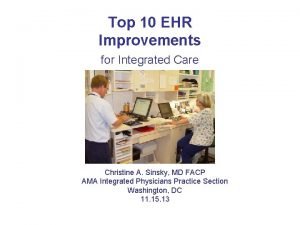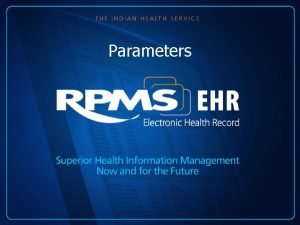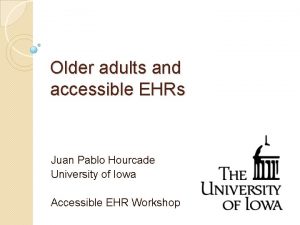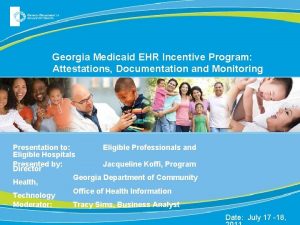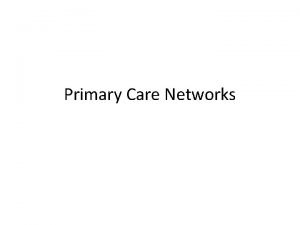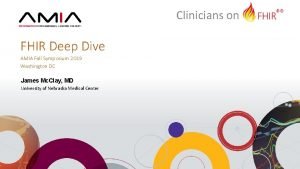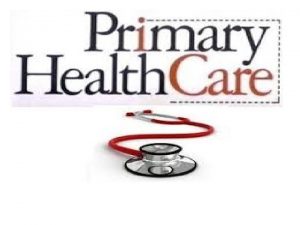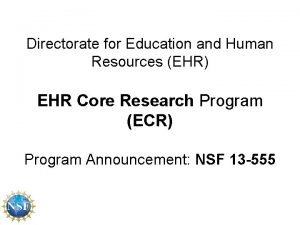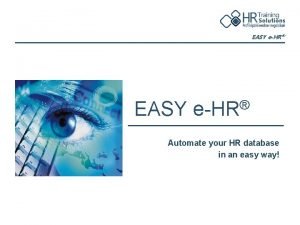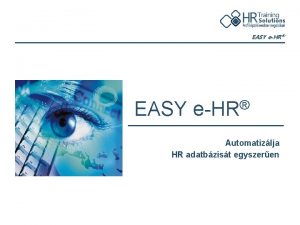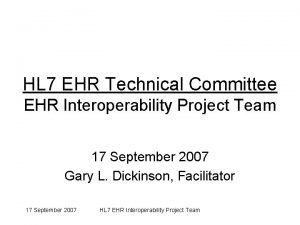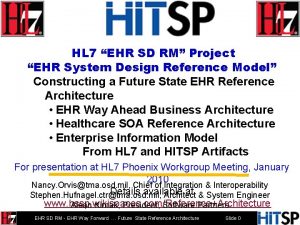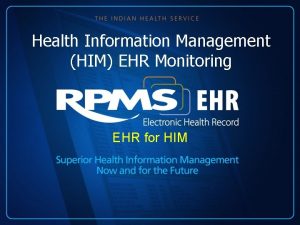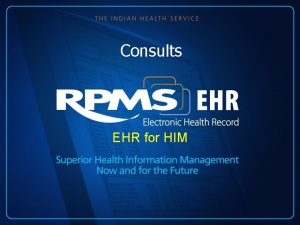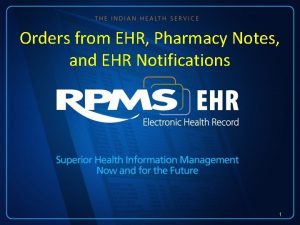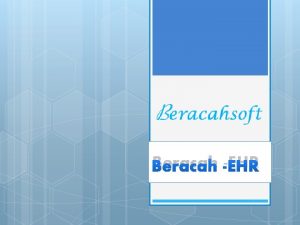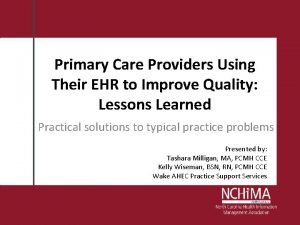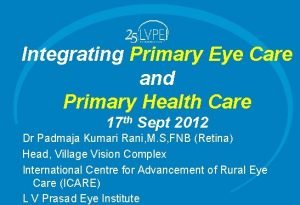Primary Care Requirements for EHR AMIA Symposium 2017






































































- Slides: 70

Primary Care Requirements for EHR AMIA Symposium 2017 Primary Care Informatics Workgroup Alan E Zuckerman MD FAAP aez@georgetown. edu Jeffrey Weinfeld MD MBI FAAFP weinfelj@georgetown. edu Georgetown University School of Medicine Washington DC 20007

Disclosure • Dr. Zuckerman discloses that he has no relationships with commercial interests. • Dr. Weinfeld discloses that he has no relationships with commercial interests. 11/04/2017 AMIA 2017 PCIWG Workshop 2

Learning Objectives • After participating in this activity, the learner should be better able to: • Define 8 key attributes of primary care and connect each of the attributes to functionality an EHR can provide • Identify at least three things are not working well with EHR support of primary care • Describe one or more use cases that illustrate what is required for an EHR to provide good primary care support • Explain one or more reasons why EHR is not meeting the needs of primary care • Identify one or more solutions that could improve EHR ability to state it. Workshop as a right for pc providers 11/04/2017 support primary care and AMIA 2017 PCIWG 3

Overview • The attributes of Primary Care and their implications for EHR. • What is not going well. • Primary Care use cases illustrate how an EHR can support primary care properly. • What went wrong and how can we fix it. • A primary care clinician’s Bill of Rights: What providers are entitled to expect from an EHR. • Next steps to get to where we want to go? 11/04/2017 AMIA 2017 PCIWG Workshop 4

The Attributes of Primary Care Help Shape the Requirements for EHR support of Primary Care Alan E Zuckerman MD We Need a Frame of Reference That Defines Our Values 11/04/2017 AMIA 2017 PCIWG Workshop 5

Sources of the IOM Definition of Primary Care • The IOM definition of Primary Care was first articulated in • Donaldson MS, Yordy KD, Lohr KN, et al. Primary Care: America’s Health in a New Era. Washington, DC: National Academy Press, 1996. 11/04/2017 • And was later summarized in • Krist AH, et al. : Electronic health record functionality needed to better support primary care. J Am Med Inform Assoc 2014; 21: 764– 771 2014. AMIA 2017 PCIWG Workshop 6

Key Primary Care Attributes Defined by the Institute of Medicine (IOM) • Primary Care is … • Accessible • Coordinated • Sustained [or Continuous] • Comprehensive • A Partnership with Patients • Person-centered • Integrated • Accountable 11/04/2017 AMIA 2017 PCIWG Workshop 7

How Can an EHR Make Care Accessible? • Accessible means accessible in terms of patients both being able to have a primary care clinician and being able to receive care when needed and convenient. • An EHR can promote accessibility by: • Making primary care providers more efficient. • Allowing patients to book appointments. • Coordinating care with urgent care and emergency departments. • Preventing clinician burnout. 11/04/2017 AMIA 2017 PCIWG Workshop 8

How Can an EHR Make Care Coordinated? • Coordinated means across all services and settings, proactively providing all needed care and information in the right sequence, and appropriately using resources. • An EHR can promote coordinated care by: • Sharing data between primary care and specialists. • Improved communication within the office 11/04/2017 AMIA 2017 PCIWG Workshop 9

How Can an EHR Make Care Sustained? • Sustained means providing longitudinal care over a patient’s lifetime, as opposed to a single encounter or isolated exchange, and continuous care for events occurring is disparate settings over time. • An EHR can promote sustained care by: • Integrating information from all providers. • Visualizing data over a patient’s lifetime. • Transferring usable records to future new practices. • Efficiently visualizing a patient summary for a patient not seen before. • Providing reminders for tasks in preventive care and chronic care. 11/04/2017 AMIA 2017 PCIWG Workshop 10

How Can an EHR Make Care Comprehensive? • Comprehensive means addressing the entire scope of services (prevention, chronic care, acute care, and mental health) at any given Stage of a person’s life, and being delivered in all needed settings (office, home, emergency room, hospital, and nursing home). • An EHR can promote comprehensive care by: • Keeping preventive care needs visible at all times in all settings. • Brings needed medical information to the point of care. • Improving communication between different care settings. 11/04/2017 AMIA 2017 PCIWG Workshop 11

How Can an EHR Make Care A Partnership with Patients? • A Partnership with Patients means focusing on therapeutic alliance and relationship-based approach to care to help advocate for and guide patients through the health system, seek agreement on health goals, and account for each individual’s values and preferences. • An EHR can promote a partnership with patients by: • Displaying patient preferences (beyond just advance directives) to all providers. • By visualizing the patient’s family, occupation, and home situation. • By accepting patient collected data. • By providing patients their data in usable and understandable form. 11/04/2017 AMIA 2017 PCIWG Workshop 12

How Can an EHR Make Care Person-centered? • Person-centered means addressing whole person care and delivered in the context of family (living conditions, family dynamics, and cultural background) and community (context for identity, source for social and psychological support, and determinant of the patient’s environment). • An EHR can promote person-centered care by: • Making the family context of care known to the current provider. • Clearly documenting patient values and preferences and retaining responses to experience with previous therapies • Accepting and using patient provided data particularly on “as needed” or “emergency” medications 11/04/2017 AMIA 2017 PCIWG Workshop 13

How Can an EHR Make Care Integrated? • Integrated means creating a system that allows all of the primary care attributes to function within practices, across the entire care delivery system, and throughout community population. • An EHR can promote integrated care by: • Sharing information between all of a patient’s providers and settings even if they are not on the same corporate vertically integrated system. • By importing discrete data by a patient summary, such as a new medication or a new lab result, into an EHR as computable data and not just human readable data. 11/04/2017 AMIA 2017 PCIWG Workshop 14

How Can an EHR Make Care Accountable? • Accountable means primary care clinicians and the systems in which they operate are responsible to their patients and communities for addressing a large majority of personal health needs through a sustained partnership with a patient in the context of a family and community and for (1) quality of care, (2) patient satisfaction, (3) efficient use of resources, and (4) ethical behavior. • An EHR can promote accountable care by: • Implement quality of care assessment and improvement projects. • Improve efficient use of resources. • Supporting good population medicine practices. 11/04/2017 AMIA 2017 PCIWG Workshop 15

AAFP Vision for a Principled Redesign Of Health Information Technology • Envision a future state that involves the principled redesign and implementation of health information technology (IT) that optimally supports the health and health care of the US populace. • Move beyond present-day constraints to envision a future health care system where primary care has a central role in making meaningful improvements in the health of the individuals, communities, and populations that they serve, and in which health IT is a critical enabler of that work. • Technology was not “a fix” for what everyone took to be a “broken” health care system. • Technology will facilitate an ease of knowing, allowing individuals and their health care professionals to have a comprehensive view of their health, which includes individual, community, and environmental aspects of health, and to use this information in developing and executing personalized care plans. From: The American Academy of Family Physicians: Vision for a Principled Redesign of Health Information Technology. Ann Fam Med 2017; 15(3): 285 -286. 11/04/2017 AMIA 2017 PCIWG Workshop 16

The Constraints of Primary Care Influence the Expectations and Need for EHR • Primary care clinicians have limited patient contact time so they must work efficiently to get everything done. • Primary care clinicians see a wide range of acute and chronic problems as well as provide comprehensive preventive care so they need reminders, point of care information access, and effective visualization of patient data. • Primary care providers have limited technical support in the patient care ambulatory setting. • Primary care providers have low budget priority in large organizations making system customization unlikely and slow. 11/04/2017 AMIA 2017 PCIWG Workshop 17

How What We are Doing Now is Not Working For Primary Care Jeffrey Weinfeld MD We Need to Align EHR with the Needs of Primary Care 11/04/2017 AMIA 2017 PCIWG Workshop 18

Outpatient EHR Adoption 2015 86. 9% using any system, 77. 9% certified systems, 53. 9% basic system Office of the National Coordinator for Health Information Technology. 'Office-based Physician Electronic Health Record Adoption, ' Health IT Quick-Stat #50. dashboard. healthit. gov/quickstats/pages/physician-ehr-adoption-trends. php. December 2016, accessed 10/16/17. 11/04/2017 AMIA 2017 PCIWG Workshop 19

PCMH Meaningful use ACOs QPP MIPS/MACRA Unrelenting change!

Quality Measure 11/04/2017 EHR Click box AMIA 2017 PCIWG Workshop 21

The Computer Is Becoming a Barrier to Doctor Patient Communication Second opinion from the computer 11/04/2017 Look at the patient not just at their labs AMIA 2017 PCIWG Workshop Refer patient to another doctor’s blog 22

Pajama Time 1 – 2 hours per night on computer and clerical work (Sinsky C. Annals of Internal Medicine 2016) 48 minutes per day EHR-associated loss of free time (Mc. Donald CJ. JAMA IM 2014)

Physician Burnout a Problem 54% of Physicians burnt out! Shanafelt. Mayo Clin Proc. 2015; 90(12): 1600 -1613

Quadruple aim From Triple to Quadruple Aim: Care of the Patient Requires Care of the Provider. (Bodenheimer T and Sinsky C. Ann Fam Med 2014; 12: 573 -576. doi: 10. 1370/afm. 1713) 11/04/2017 AMIA 2017 PCIWG Workshop 25

Primary Care Challenges in Using EHRs Usability • Functionality Communication • Psychosocial Zhang J, et al. JAMIA 2016; 23: 137– 143

There is a Need for Radical Revision of Billing / Coding Guidelines • Get rid of Review of Systems • Focus on Medical Decision Making 11/04/2017 AMIA 2017 PCIWG Workshop 27

Implementation Issues • Long training times • “How can we tailor this for you? ” instead of “What do you want here? ” • Unconfigured and Clinical Decision Support • We need to learn from each and share tools that work. • Start with a “best practices” set of content instead of a blank shell 11/04/2017 AMIA 2017 PCIWG Workshop 28

Important Primary Data is Missing from Many Records • Primary care provider/team • Patient generated data • Data from received patient summaries • Data from other organizations 11/04/2017 AMIA 2017 PCIWG Workshop 29

Primary Care Use Cases Illustrate How an EHR Should Support Primary Care Jeffrey Weinfeld We Need a Model of Excellence 11/04/2017 AMIA 2017 PCIWG Workshop 30

What is a Primary Care Use Case? • A Use Case is a written description of how a user will perform specific tasks • It highlights • • • The goal of the task The information requirements The parties and stakeholders who participate in the task The sequential exchange of information that is required The displays and visualization of the task How completing the task will satisfy goals and requirements • A primary care use case illustrates what is needed to deliver on the attributes From https: //www. usability. gov/how-to-and-tools/methods/use-cases. html 11/04/2017 AMIA 2017 PCIWG Workshop 31

Primary Care Use Cases part 1 Jeffrey Weinfeld Components of a Patient Encounter 11/04/2017 AMIA 2017 PCIWG Workshop 32

Writing a Note • Use case – A note is generated during the visit with minimal effort from the physician. The note writing process does not impede doctor-patient communication. Editing is possible at any time and is fully versioned. • A critical part of the record • Varies from unstructured to partly structured by EHR • Should flow naturally from what is done in the record • Should not contain extra text that is unnecessary (note-bloat) 11/04/2017 AMIA 2017 PCIWG Workshop 33

Determining the Primary Care Provider • Continuous Care requires knowing if the person seeing the patient is the primary care provider, or if not, who is. • Residents as PCP vs attending vs billing provider. • Knowing the primary care provider enables the type of communication needed for coordinated care and integrated care. • Opportunity for targeted CDS 11/04/2017 AMIA 2017 PCIWG Workshop 34

Knowing Why the Patient Came to See You • Patient-centered care requires understanding why a patient came to see a provider at a given point in time. • Chief Complaint or reason for visit usually not coded and not always the same. • Integrating acute care with chronic care and preventive care is essential to provide comprehensive care. • Navigating a problem oriented medical record may require moving between data entry to assessment and plan for different problems as they come up in the course of an encounter rather than sequential movement from one section of the EHR to another. The agenda for a visit changes during the visit. 11/04/2017 AMIA 2017 PCIWG Workshop 35

Knowing About Other Recent Encounters and Tests and Who is Managing Which Problems • Integrated and Continuous care requires understanding all of a patient’s providers and events that have occurred since the last encounter with the primary care practice. • Encounter List vs Provider list vs Document List (with authors but no setting) • A primary care friendly EHR can sort out episodes of illness and episodes of care linking multiple phone messages and documents to an encounter for a specific problem. 11/04/2017 AMIA 2017 PCIWG Workshop 36

Transfer of Care After an ER Visit or Hospitalization • An interesting by-product (? Unintended consequence) of the Meaningful Use EHR Incentive Program is a proliferation of Patient Summary Documents (in CCD format). • Integrated care requires assimilation of key data in these transfer of care documents into the primary care record which requires reconciliation not just of medications, but also problems, immunizations, labs, and other data. • Some steps are mandated such as medication reconciliation at hospital admission, hospital discharge, and outpatient visits – many other steps seem to fall through the cracks. 11/04/2017 AMIA 2017 PCIWG Workshop 37

Chronic Disease Management using Quality Assurance (QA) and Clinical Decision Support(CDS) • A key challenge to both QA and CDS is having the right data to support guidelines. • An EHR can both re-use existing data and prompt for additional clinical data that needs to be structured and codes. • Often requires custom development. • Just-in-time reminders and prompts need to be intelligent to avoid alert fatigue and inappropriate recommendations. • The problem list alone may not be adequate to trigger correct chronic disease identification 11/04/2017 AMIA 2017 PCIWG Workshop 38

Use of Patient Generated Data • Part of building a Partnership with Patients requires that we use data that only a patient can provide to their primary care provider. • Patients are using apps and devices that capture important data on fitness, use of “as needed” medications, home monitoring of physiologic parameters and patients expect their doctor to be interested and able to use the information. • Most EHR are not yet equipped to handle this type of patient generated data and security fears and time constraints are rate limiting barriers that even many patient portals cannot overcome. 11/04/2017 AMIA 2017 PCIWG Workshop 39

Giving a Patient a Visit Summary at the end of the Visit • MU regulations are driving primary care clinicians to provide patient summaries. • What most EHR can generate is far from ideal, may rely too heavily on the provider to generate narrative text, and does not necessarily meet the patient’s needs to maintain a personal health record. • Better - maximize auto-population of data, set up tracking and notification for key tasks that both the provider and patient need to do after the encounter is over. 11/04/2017 AMIA 2017 PCIWG Workshop 40

Primary Care Use Cases Part 2 Alan E Zuckerman MD Visualizing the Data 11/04/2017 AMIA 2017 PCIWG Workshop 41

What is Data Visualization? • Continuous Care requires effective data visualization • Every EHR will have a problem list, medication list, allergy list, immunization list, vitals signs, and lab results; but what we get is usually just the raw data. • Creative processing of the data, summarization over time, and graphical display enhance our ability to use large amounts of data that will accumulate over a patient’s lifetime of primary care. • The Pediatric Growth Chart is an excellent example of the need to creatively visualize data and a Boston Children’s app implemented using FHIR is a powerful demonstration of what can be done. 11/04/2017 AMIA 2017 PCIWG Workshop 42

Medication Reconciliation Twin. List Demo Revisited • It is not surprising that this mandatory task has been called “Med. Wreck” as it is often not done very well and takes a lot of provider effort. • The 2011 University of Maryland Human Computer Interface Lab (HCIL) Twin. List demos are a great example of what a computer can do to make the task easier and thrilled audiences at AMIA 2012. • It is open source code, yet who is using it? • A look at both demo 1 and demo 2 provides insight into how analysis of the task can help design a better EHR. 11/04/2017 AMIA 2017 PCIWG Workshop 43

Twin. List Demo Novel Interfaces for Medication Reconciliation • Twinlist Demo (part 1) Introduction to Twin. List • https: //www. youtube. com/watch? v=Yo. Sxl. Kl 0 p. Co • Twinlist Demo (part 2) Advanced Features and Alternative Designs • https: //www. youtube. com/watch? v=d. ABfks. Dv. Oiw • University of Maryland Human Computer Interaction Laboratory • www. cs. umd. edu/hcil/sharp/twinlist 11/04/2017 AMIA 2017 PCIWG Workshop 44

Comprehensive Lifetime Medication List • To support sustained care and comprehensive care, an EHR should support lifetime visualization of medications. • Most EHR focus on the active medication list based on recent prescriptions. • A comprehensive list should separate categories of medication by Acute, Chronic, As needed, and Emergency. • Some inactive medications have lifetime significance. • PRN or as needed medications need patient data on use to form an effective partnership with patients. • Chronic meds should be visualized to see start and end dates, changes in dosage over time, even changes in specific med within a class. • Refills need to be proactively monitored and may be needed for emergency meds even if never used. 11/04/2017 AMIA 2017 PCIWG Workshop 45

Comprehensive Lifetime Problem List • A dynamic problem list, visualized over time supports more effective comprehensive and continuous care. • Problems occur in episodes that can be visualized over time with start and end dates and numbers of visits both to primary care and to specialists. • Problems transition over time and the name or codes may change. • Status and severity of problems is an important item of data to capture and code as a guide to quality measurement. 11/04/2017 AMIA 2017 PCIWG Workshop 46

Comprehensive Lifetime Immunization History with Immunization Forecasting • Immunizations are a type of data in an EHR that must be viewed in a lifetime perspective and must be able to move between practices and providers. • Immunization data is an idea target to encapsulate in a portable data model that moves with the patient and preserves all coding for future use in the same or another EHR. This is one type of data that never should be stored in proprietary formats. • Encapsulated digitally signed data is never altered, but data imported and exported from immunization registries (IIS), needs reconciliation to correct small variations. • Harmonization of FDA NDC barcodes and CDC CVX codes is possible including group CVX mapping to components of multiple target vaccines. 11/04/2017 AMIA 2017 PCIWG Workshop 47

Transfer of Primary Care to or from Another Practice • It is inevitable that patients will move, practices will re-structure, and practices will sometimes need to change EHR vendor or system. • Sustained care for a patient requires us to deal with transitions of the primary care setting or record that is a more complex task than transfer of care after an ER visit, Hospitalization, or Specialist Visit. • Much of the data in a patient record is repetitive and may have limited value over time. • Transfer of active demographics, medications, allergies, problems, vital signs and immunizations is essential to continue to meet immediate care needs but more is need to preserve the rich personcentered history of previous providers. 11/04/2017 AMIA 2017 PCIWG Workshop 48

Can We Really Transfer a Complete Patient Record Between Two EHRs? • YES but we need to make a lot changes in our EHRs first. • The time to begin planning for conversion to another system is the day you install your current system. • We must divide our records into computable data and Human readable data that MUST be able to move with the patient. • We need to isolate administrative and operational overhead data. • All Human readable data (notes, documents, reports, etc. ) must be in a “clinical document architecture” with a meta-data header and a body of structure content. • All computable data (vital signs, labs, medications, problems etc. ) must be in well documented structured and coded standardized data objects. 11/04/2017 AMIA 2017 PCIWG Workshop 49

Newborn Hospital Discharge • There are few examples that involve as much “Mandatory Interoperability” between several partners and where the data has very time specific value and need to separate the patient specific exceptions from the sea of routine information. • Data is merged from the mother’s prenatal record, the mother’s delivery record, the infant’s nursery record, and newborn screening data and shared with the primary care provider, specialists, and public health. • ACOG has set excellent standards for maternal data, but we still lack comparable infant data standards from AAP. • Communication to public health on all point of care and laboratory newborn screening is essential to maintain quality of care. 11/04/2017 AMIA 2017 PCIWG Workshop 50

What Went Wrong and How Can We Fix It? Alan E Zuckerman MD We Need To Focus on Solutions Not Blame 11/04/2017 AMIA 2017 PCIWG Workshop 51

No Single Party or Explanation is Responsible for the Limitations of Primary Care EHR • Many factors are contributing the limitation of current EHR for primary care. • Vendors alone are not responsible and vendors alone cannot fix it! • Government regulations have consumed much available development effort for EHR and changed what we do during an encounter. • Local implementations of the same EHR system are extremely variable and are often more important to the clinician user than which system they are using. • Interoperability by its nature requires two parties to cooperate and a single EHR alone cannot guarantee that it will work. 11/04/2017 AMIA 2017 PCIWG Workshop 52

Meaning Full Use Incentives Put EHRs into the Hands of Most Primary Care Physicians • The Meaningful Use Program drove EHR adoption past the tipping point. • The Meaningful Use Requirements were directed at many primary care needs • Transfer of care documents • Patient summaries given to patients • Immunizations sent to registries • What happened often did not meet full expectations because interoperability is a complex task that requires two parties to work together and agree to exchange data that can be used in computable form. 11/04/2017 AMIA 2017 PCIWG Workshop 53

What Happens When Best Available is Not Good Enough? • Government regulations are driven by the need to implement on a time line that requires using the best available standards or systems. • Interoperability standards for vocabularies, messages, and documents are always based on best available and usually controlled by a single stakeholder. We need to be able to label some things as not good enough and focus on fixing the limitations. Even e. Rx has limitations. • Yes we have a very large EHR user base, but dissatisfaction and problems with usability and workflow will prevent reaching the most important goals. • Some features of electronic records will always bring benefits of availability, multiple access, legibility, structure, and search potential; but full benefits take more than just electronic storage to achieve. 11/04/2017 AMIA 2017 PCIWG Workshop 54

Most EHR are Still Emulating Paper Records • Many computer applications began by emulating paper records and procedures, but the real potential of EHR requires more creative thinking. • As long as billing audits are based on pay for documentation will be verbose, less information dense than needed, and not necessarily ideal to support care. • New reimbursement policies are opening opportunities to use the record to improve outcomes and the ability to support value based care. • Quick text and other documentation short cuts may be decreasing our ability to create true person-centered records that focus on individual differences and not standard expectations. 11/04/2017 AMIA 2017 PCIWG Workshop 55

We are Not Using the Best Tools that Computer Science and Other Industries Use • We are not Using artificial intelligence and machine learning to Improve usability. Other applications learn from user behavior and modify system behaviors to improve future interactions. • Most EHR do not attempt to use animation, creative graphics, and visualization tools to summarize data over time and to drill down to the level of detail needed for specific tasks. The science of human computer interaction has done little to inform the design of EHR. • Searching within a patient record, across a practice, or across patients with similar problems is not readily available at the point of care. • We do not effectively integrate all members of the team including residents and students into the process of documenting an encounter. 11/04/2017 AMIA 2017 PCIWG Workshop 56

Our Approach to Interoperability is Flawed by Focusing on the Messages and Documents • Our approach to interoperability is flawed because it focuses on the format of messages and documents and not on data models internal to the EHR. • This explains why it is so much easier to export a document than to import discrete data elements. • FHIR is trying to correct this problem, but only at the level of the application programming interface (API) that limits what end users can expect of vendors without development costs. • Even our very successful lab result standards and LOINC codes require custom interfaces, EHR generated human readable displays, and typically do not retain the LOINC codes in the EHR to support QA and CDS. 11/04/2017 AMIA 2017 PCIWG Workshop 57

Our Approach to Using Coding and Terminology is Flawed • Primary care was a leader in development of new coding vocabularies to meet critical gaps in existing tools leading to the Read Codes and IHCPPC that are now part of SNOMED CT • Having good vocabularies and terminologies is worthless if we do not actual use them. • We need to support multiple coding systems within EHR to adequately address primary care needs • Both ICD 10 CM for billing and SNOMED CT for problems • Both NDC for sending an Rx to a pharmacy and Rx. Norm for medication lists • NDC and CDC codes for immunizations • We need to retain codes so that data exported matches data imported • We also should retain and encapsulate the source of the data 11/04/2017 AMIA 2017 PCIWG Workshop 58

Primary Care Clinicians and Professional Societies are Not Engaged in the Politics of Standards • It is very expensive and time consuming for primary care clinicians to engage in standards development organizations. • There are key roles that professional societies can and must play in defining content, data models, and vocabularies to support the type of interoperability that is essential to primary care. • Electronic prescribing may be very successful but was controlled by retail pharmacies hence weight based dosing for pediatrics was not supported for a long time and we are still trying to move beyond free text dosing to allow structured SIG to compute daily doses. • Pharmacies require NDC codes, but it has long been recognized that clinicians need Rx. Norm to merge medication in different dosage form and manufacturer and to map to pharmacologic classes. 11/04/2017 AMIA 2017 PCIWG Workshop 59

A Primary Care Clinician’s EHR Bill of Rights Alan Zuckerman MD What we should be able to expect an EHR to do! 11/04/2017 AMIA 2017 PCIWG Workshop 60

What is a Bill of Rights and How is It Different From a Wish List? • A Bill of Rights should define inalienable rights that nobody should be able to take away. • In a primary care context, this should mean critical data elements, functionality, and visualization without which, a primary care clinician cannot practice effective and appropriate primary care. • This is not a wish list of things that would be nice to to make life easier, this is a declaration that without these core capabilities, good primary care will not happen. • Yes we are able to compensate and do more manually or expend more resources to survive in an imperfect world, but this is a way to say that some things absolutely need to change. 11/04/2017 AMIA 2017 PCIWG Workshop 61

A Primary Care Clinician Should Expect an EHR to … 1. Correctly identify the primary care provider and team. 2. Be intuitive to use as demonstrated by brief training time and speed of note completion 3. List encounters in a structured format (not just use documents as an index to care received). 4. Import and reconcile all key data from any patient summary. 5. Generate a useful prepopulated visit summary with minimal effort. 6. Provide EHR flexibility to facilitate teamwork and let patients, MA, and nursing participate in documentation 11/04/2017 AMIA 2017 PCIWG Workshop 62

A Primary Care Clinician Should Expect an EHR to … 7. Communicate with pharmacies to see if prescriptions are filled and refilled appropriately. 8. Accept patient generated data. 9. Provide electronic data for import into a patient’s PHR or another system 10. Enable user searching of a parallel database copy on a single patient record or across patient records to support patient care and quality assessment. 11. Enable implementation of standard quality measures from the measure definition file without custom programming. Display quality measures on a provider and practice level, and identify patients who do not meet specific measures. 12. Include decision support for USPSTF recommendations and ACIP vaccination recommendations without user programming. 11/04/2017 AMIA 2017 PCIWG Workshop 63

A Primary Care Clinician Should Expect an EHR to … 13. Maintain a lifetime comprehensive problem list that includes episodes of illness and episodes of care. 14. Maintain a comprehensive lifetime medication list with appropriate summary formats and structure by therapeutic class 15. Maintain an accurate lifetime immunization record with appropriate immunization forecasting of needs. 16. Accept lab reports from any laboratory with the need to create custom interfaces and programming to provide a human readable report. 17. Retain standard data field coding of vital signs, lab results, problems, and medications to allow use of standard quality measure definition files to implement themselves without custom programming. 18. Transfer complete patient records between different practices and different vendor EHR systems. 11/04/2017 AMIA 2017 PCIWG Workshop 64

A Primary Care Clinician Should Expect an EHR to … 19. Retain codes from imported data such as lab reports or c. CCD patient summaries to enable their future re-use. 20. Support dual coding of • Problems (ICD 10 CM and SNOMED CT) • Medications (NDC and Rx. Norm) • Immunizations (NDC and CDC ) 21. Retain data source metadata of imported data to share on reexport. 22. Support predictable use of FHIR APIs based on codes without custom programing (reduce the need for FHIR profile to map to local databases). 11/04/2017 AMIA 2017 PCIWG Workshop 65

Why Do We Need Dual Coding? • Dual coding may sound like an extra burden, but it may be key to reaching our goals including semantic interoperability. • Dial coding does NOT mean dual entry. Computers can translate from the primary code to the required secondary code. • Without dual coding, patients will continue to complain about “errors” in their medical records. • Without dual entry, transfer of complete patient records will be very difficult because we will need to reconcile EHR terminology. • Dual coding may be the key to ending proprietary terminology and free text pick lists in EHR. 11/04/2017 AMIA 2017 PCIWG Workshop 66

Summary, Conclusions, and Next Steps Jeffrey Weinfeld MD The Road Ahead Today and in the Future 11/04/2017 AMIA 2017 PCIWG Workshop 67

Novel EHR Metrics to See if the System is Working • Work after work hours • Click counts • Teamwork – how much does staff do vs what clinician does? • Being present – rate of visits where assistance provided • “Fair pay” – Tracks uncompensated admin work in the EHR • Regulatory Balance – tracking clicks required by regulation Di. Angi et al. Ann Intern Med. doi: 10. 7326/M 17 -0658 11/04/2017 AMIA 2017 PCIWG Workshop 68

Summary and Conclusions • The attributes of primary care should drive EHR requirements – accessible, coordinated, sustained, comprehensive, a partnership with patients, person-centered, integrated, and accountable. • Current EHRs are not meeting the needs of primary care. • Primary care use cases illustrate what we could do better. • There is no single cause of the problem, but vendors can play a role. • Changes in regulations, standards and a focus on outcomes may help. • A primary care bill of rights could be a tool for setting priorities and focusing on essential tasks. • The AMIA Primary Care Informatics Workgroup could help lead the way forward. 11/04/2017 AMIA 2017 PCIWG Workshop 69

Next Steps • The next speakers will illustrate three key strategies: • Use Fast Health Interoperability Resources (FHIR) to enhance and add functionality to current EHR using API plug-in apps. • Use primary care and informatics education to improve use of EHR and guide future implementations and development. • Use practice re-engineering to address the attributes and make the use cases work. • The AMIA PCIWG could undertake projects to continue the process • • Publish a white paper on primary care and EHR. Refine and publicize a Primary Care Bill of Rights for EHR. Develop, disseminate, and test FHIR apps for primary care. Engage in development of relevant standards, data models, and FHIR 11/04/2017 AMIA 2017 PCIWG Workshop 70
 Amia 10 x 10
Amia 10 x 10 Level of care primary secondary tertiary
Level of care primary secondary tertiary Osha racking requirements 1910
Osha racking requirements 1910 Interqual level of care criteria 2017
Interqual level of care criteria 2017 The shampoo service actually encompasses
The shampoo service actually encompasses Ireton-jones equ. energy requirements in critical care pts.
Ireton-jones equ. energy requirements in critical care pts. What are two basic requirements for a healthy scalp
What are two basic requirements for a healthy scalp Planned parenthood ehr
Planned parenthood ehr Pssproject
Pssproject Nextgen lab
Nextgen lab Rugs to pdpm crosswalk
Rugs to pdpm crosswalk Service electronic
Service electronic Https://eszemelyugy.gov.hu
Https://eszemelyugy.gov.hu ányk kaü azonosítás sikertelen
ányk kaü azonosítás sikertelen Hl7 ehr system functional model
Hl7 ehr system functional model Ehr project management
Ehr project management Ehr nijmegen
Ehr nijmegen Iuse ehr
Iuse ehr Ehr implementation work breakdown structure
Ehr implementation work breakdown structure Rpms ehr
Rpms ehr Rpms ehr
Rpms ehr Rpms ihs
Rpms ihs Ehr readiness assessment
Ehr readiness assessment Ehr migration path
Ehr migration path Change management in ehr implementation
Change management in ehr implementation Emr ehr phr
Emr ehr phr Holistic medicine ehr
Holistic medicine ehr Ehr risk management
Ehr risk management Puh ehr
Puh ehr Pain management ehr
Pain management ehr Ehr alerts and reminders
Ehr alerts and reminders Top 10 ambulatory ehr vendors
Top 10 ambulatory ehr vendors Rpms ehr
Rpms ehr Nextgen crystal report
Nextgen crystal report Ehr
Ehr Day camp ehr
Day camp ehr Tribal health emr
Tribal health emr Indian health service ehr
Indian health service ehr Ihs ehr
Ihs ehr Tribal health ehr
Tribal health ehr Service electronic
Service electronic Workflow process mapping for ehr implementation
Workflow process mapping for ehr implementation Ehr.fn
Ehr.fn Ihs ehr
Ihs ehr Picasso ehr
Picasso ehr Ny medicaid ehr incentive program
Ny medicaid ehr incentive program Formuö
Formuö Novell typiska drag
Novell typiska drag Tack för att ni lyssnade bild
Tack för att ni lyssnade bild Returpilarna
Returpilarna Shingelfrisyren
Shingelfrisyren En lathund för arbete med kontinuitetshantering
En lathund för arbete med kontinuitetshantering Adressändring ideell förening
Adressändring ideell förening Personlig tidbok
Personlig tidbok Sura för anatom
Sura för anatom Densitet vatten
Densitet vatten Datorkunskap för nybörjare
Datorkunskap för nybörjare Tack för att ni lyssnade bild
Tack för att ni lyssnade bild Tes debattartikel
Tes debattartikel Magnetsjukhus
Magnetsjukhus Nyckelkompetenser för livslångt lärande
Nyckelkompetenser för livslångt lärande Påbyggnader för flakfordon
Påbyggnader för flakfordon Formel för lufttryck
Formel för lufttryck Offentlig förvaltning
Offentlig förvaltning Kyssande vind analys
Kyssande vind analys Presentera för publik crossboss
Presentera för publik crossboss Jiddisch
Jiddisch Bat mitza
Bat mitza Treserva lathund
Treserva lathund Fimbrietratt
Fimbrietratt Bästa kameran för astrofoto
Bästa kameran för astrofoto


